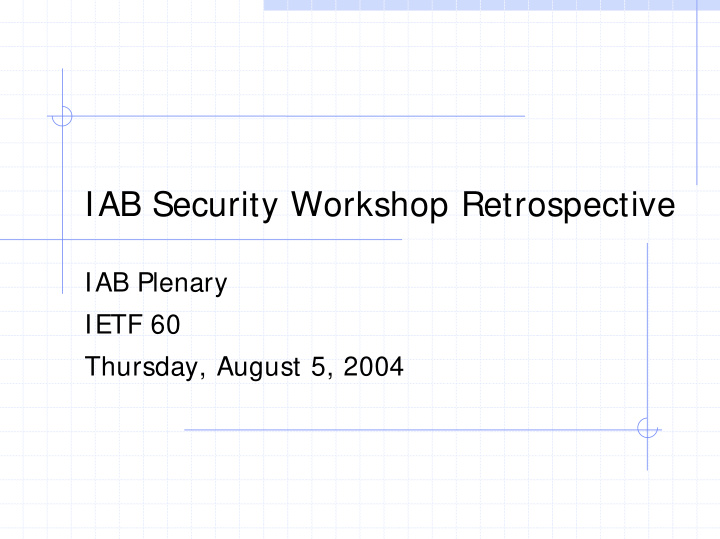



IAB Security Workshop Retrospective IAB Plenary IETF 60 Thursday, August 5, 2004
Acknowledgments Many thanks to Steve Bellovin for his thoughts and recollections. Any errors or omissions are the responsibility of the presenters 8/6/2004 2
RFC 2316 – A Synopsis Report of the IAB Security Architecture Workshop � Held on March 3-5, 1997 at Bell Labs in Murray Hill, NJ Goals � To identify the core security components of the Internet architecture � To specify documents that needed to be written. � To provide useful security guidance to protocol designers. Points of agreement � Agreed that security was not optional and that it needed to be designed in 8/6/2004 3
1997: The Good Old Days… CERT Incidents by Year 160000 140000 120000 Incidents You are here 100000 80000 60000 40000 20000 0 8 9 0 1 2 3 4 5 6 7 8 9 0 1 2 3 8 8 9 9 9 9 9 9 9 9 9 9 0 0 0 0 9 9 9 9 9 9 9 9 9 9 9 9 0 0 0 0 1 1 1 1 1 1 1 1 1 1 1 1 2 2 2 2 Year 8/6/2004 4
What Hasn’t Changed Trends � Rate of attacks is increasing � The attackers have gotten smarter Several conclusions of RFC 2316 are now common wisdom � Security needs to be built in � IETF needs to become more serious about security considerations � IPsec is not a panacea � No cleartext passwords Few new security mechanisms 8/6/2004 5
What Has Changed Scope and sophistication of attacks has grown dramatically Money now a significant motivation for exploitation of security vulnerabilities Increase in peer-to-peer protocol designs vs. client/server More multi-party protocols (SIP, AAA, etc.) Authorization increasingly important Most serious vulnerabilities are now at the application layer All this implies an evolution of the threat model 8/6/2004 6
Threat Model Evolution Old model: classic communications security threats New model � Can an attacker make money by exploiting a vulnerability? � Via “social engineering”? (phishing) � By targeting a high profile user? (blackmail) � Can an attacker cause havoc on a regional/national scale? � By attacking infrastructure? � By denying critical services? 8/6/2004 7
Mechanism Retrospective Core � DNSSEC not deployed � DNS Key RR now deprecated (opponents were right about trust model mismatch) � IPsec/ISAKMP not as widely deployed as expected/desired � TLS has been widely deployed � S/MIME not widely used � Though widely available Not core � Kerberos, RADIUS growing in popularity � SASL, EAP, GSS-API alive and well (work still ongoing) 8/6/2004 8
Deployment Lessons Ease of use a significant consideration � SSH, SSL/TLS: easy to deploy � SASL, EAP: easy for developers Deployment at the edge is easier than in the core � Edge: Client VPN � Core: Router Security Mechanisms requiring coordination are intrinsically more difficult to deploy � Examples: PKI, DNSSEC, S/MIME, PGP 8/6/2004 9
Lessons of ISAKMP Complexity is the enemy of ease of use � How do I explain an SPD to my users? General purpose crypto frameworks are hard to design � Authorization issues may make it difficult to handle all problems � Service definition may differ: � Restart vs. Child SAs � Machine vs. User Certs Will we relearn these lessons with frameworks like GSS-API, EAP, SASL? 8/6/2004 10
1997: Missing Pieces Object security � We have the protocols. � Usage in specialized applications (e.g. Authenticode) � General purpose toolkits are lacking. Secure e-mail � A demand problem. � Requires large scale changes in operations as well as user behavior. � Is implementation quality an issue? Routing security � Some progress here. 8/6/2004 11
2004: Missing Pieces Peer-to-peer security mechanisms Multi-party protocol security � Understanding trust models � Breaking the problem into known solvable problems DDoS � How do we design a protocol that’s more DoS resistant? � Are there network mechanisms to prevent DDoS? � Pushback, etc. Phishing � Are there authentication mechanisms that will help? 8/6/2004 12
Are We Working on the Right Problems? What are the most serious Internet security problems? Spreading malware � Zombie networks � � DDoS � Spam Phishing � All of these are related Its not just the vulnerability of components or individual protocols. � It is also their manner of interaction. � Looking at components in isolation got us where we are today. � These issues are not addressed by COMSEC They’re system and software security problems. � Is the IETF adequately addressing new threats in Security Considerations sections? Communications security threats vs. threats to the life and livelihood of � millions 8/6/2004 13
Identifying the Threat Models of Today’s Internet Look beyond the immediate problem � Don’t just patch the current bug � Does this vulnerability expose other vulnerabilities? � Can this fix be used to solve other problems? Document your dependencies � “This protocol assumes that protocol X functions correctly” � Look for cascading failures Understand large scale risks � The Internet is increasingly critical infrastructure � Monetary incentives can overcome difficulties in exploiting vulnerabilities � Epidemics spread fast, and develop immunity to countermeasures 8/6/2004 14
15 Feedback? 8/6/2004
Recommend
More recommend